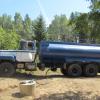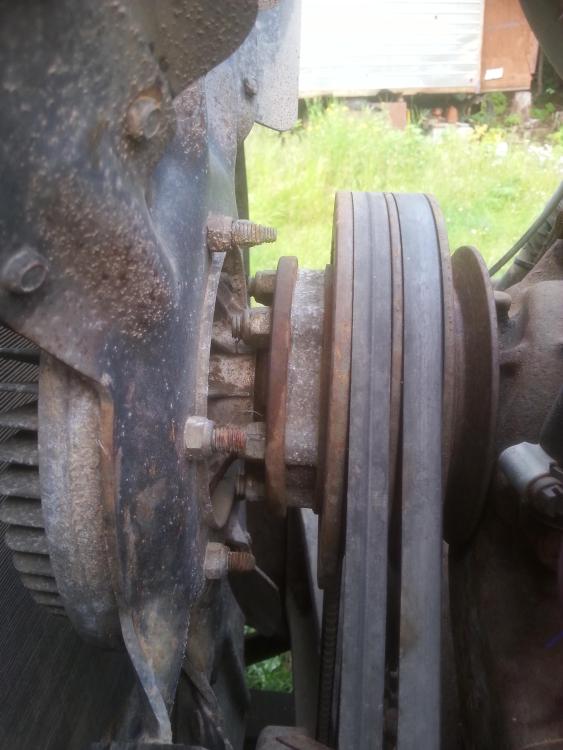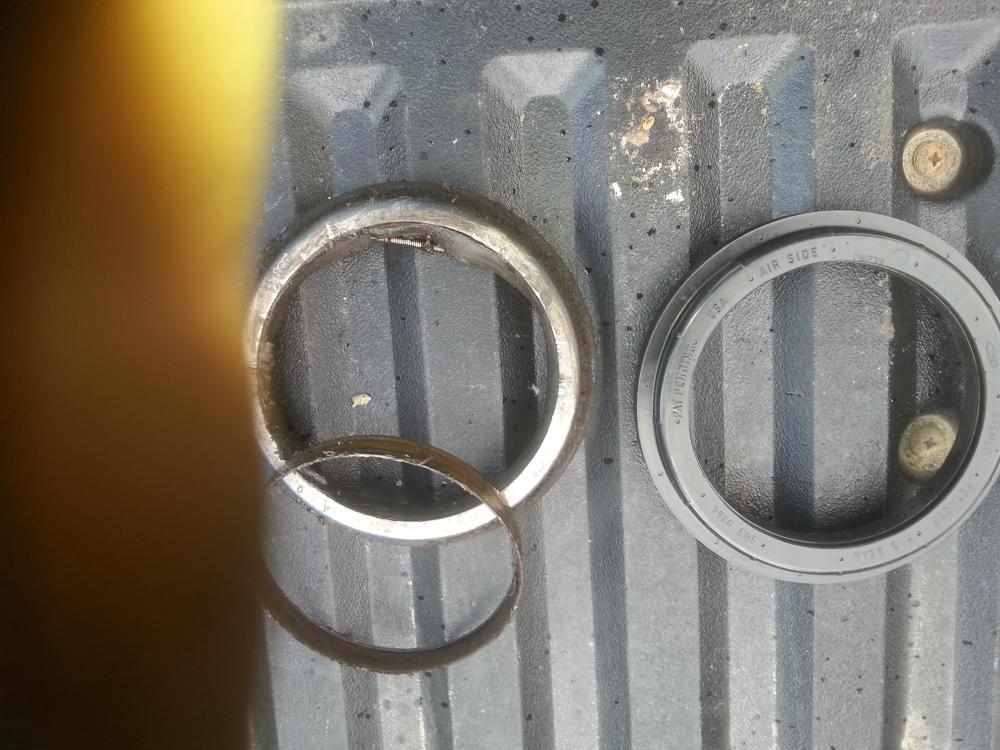-
Posts
382 -
Joined
-
Last visited
Content Type
Profiles
Forums
Gallery
Events
Blogs
BMT Wiki
Collections
Store
Everything posted by Full Floater
-
I have a 237 that has had a fan clutch installed in place of a fixed fan. And they used a pile of washers as a hub spacer (which seemed to work but it looks sloppy). Im hoping to buy this spacer....anyone know if they are available anywhere? Also, say one wanted to buy a new fan clutch, just because.... is this what im after? https://www.woodlineparts.com/en-ca/products/pai-efc-1640b-mack-38mh416-fan-clutch-e6-21-00-26-00-fan-183125
-

air shift pto
Full Floater replied to pmolitor's topic in Antique and Classic Mack Trucks General Discussion
Very interesting guys. Ya the one I have is a mechanical shift PTO. I have not engaged the PTO on that truck yet as it's just getting back together....but I will play with it both ways, main in N and aux in N. Im always a less confident with that aux box being in N position as they seem/feel less assuring as there isn't much wiggle room on the stick....so I always release the clutch real slow JUST IN CASE it's not actually in N -

air shift pto
Full Floater replied to pmolitor's topic in Antique and Classic Mack Trucks General Discussion
I'm new to the rear mount PTO on a 6 speed. Can I get any operating tips before I try to figure it out for myself? Does the main trans need to be in gear for engagement? Where should the aux box stick be positioned? -

Removing the blue tractor parking brake valve.
Full Floater posted a topic in Air Systems and Brakes
Im in the process of tiding up a bunch of hack job air line repairs and routing on a 75 R model. What are you thoughts on removing/bypassing the blue tractor parking brake valve, leaving only the yellow and red, as in more modern applications. The tractor is a straight truck and will never be pulling a trailer, so no real need to keep the trailer charged and the tractor brakes set for any reason, thus not needing the blue valve....unless it has a use that I'm not familiar with.... Just wanting to simplify things and keep the "what is the blue knob for" conversations to min with future drivers. Thanks folks. -

1975 R model, positive ground.
Full Floater replied to Full Floater's topic in Electrical, Electronics and Lighting
For sure. I had to switch voltmeters, but everything else worked in regards to gauges and interior lights. Heater motor needed the wires reversed. Not sure about low air buzzer yet, but will probably need the wires reversed. I would have left it + ground, but I installed Jacobs 675 jake heads on it and they are grounded through the casing so I figured this is my calling to convert. Really wasn't a probably, just stumped on this signal issue. But it could very well be another issue -

1975 R model, positive ground.
Full Floater replied to Full Floater's topic in Electrical, Electronics and Lighting
So far, everything has been trouble free in converting from positive to negative ground. I have only the signal lights left to get working. Im getting nothing from them, nor any power from the rectangular plug that hangs down and plugs into the signal-stat pigtail. The relay and all other relays on the relay board, are functioning. Changed flashers, to no avail. I'm suspect of this unit, mounted above the drivers side kick panel area. (this is a picture of 2 separate ones, one off of a parts truck). Anyone know if they have anything to do with the signal lights? Im at a loss as to where to look next, the harness is in tact and im hoping to leave it that way so I figured i'd ask here before I pull that harness all apart and make a mess, whilst trying to solve this problem. HOWEVER, I do not know if the signal lights were working in this truck, before biting the bullet and converting to negative ground and replacing LOTS of wiring, grounds and various things along the way in part of the restoration. So I may have had a problem to begin with, that I do not know about. -

Foot valve plumbing questions.
Full Floater replied to Full Floater's topic in Air Systems and Brakes
Ooooohhhhh!!! Sounds like something I can do away with?!?!? In exchange for using common sense and not compounding the brakes! -

Foot valve plumbing questions.
Full Floater replied to Full Floater's topic in Air Systems and Brakes
I did, sorry for the lack of responses, been tied up with other clutch problems on a different truck. I got both the front service brakes and rear air supply to a relay valve plumbed into the delivery ports, which were on the bottom if I recall correctly. (Im not in front of it at the moment). there is a small line from the foot valve that is connected to the parking brake knob for some reason, that I plumbed into the foot valve wrong as the parking brake valve won't apply the maxi's now when pulled out. I think that line has to "dump" air somewhere and I have it plumbed into a supply port I think. Not sure on whats up with that but I got the service brakes to function so I could get that truck home. So for now, mission accomplished. Thank you -

2 piece driveshaft angle question.
Full Floater replied to Full Floater's topic in Driveline and Suspension
A reply that exceeded all expectations, again! THANKS -
I am in the process of converting a tandem R600 into a single axle for a re-purpose of the truck. The overall length of the driveshaft has extended by a little over 2ft. I had the driveshaft professionally lengthened and balanced. All new u-joints and steady bearing. The location of the steady bearing is further back and I am moving a crossmember to accommodate the bracket. AND I have to use or make another steady bearing bracket as I didn't get the bracket back with the driveshaft and the driveline shop is 5hrs drive away. Can someone school me on driveshaft angles a bit? It's my understanding that the angle of all the joints should be 3 degrees or less.... what else am I missing here?
-
You're pyro probe is in the downpipe after the turbo and not in the manifold, correct? Ya don't hold it at those temps for too long.
-
Ah good to know!
-
I just bought another parts truck, with a 6 speed and a side mount with a driveshaft pump. Never actually seen a side mount on a 6 speed. Haven't got the number off of it, just something I noticed
-
Thanks. Curious as to what is better about the rear mount? Is it a stronger or more reliable location to mount the PTO, rather then the side?
-

Foot valve plumbing questions.
Full Floater replied to Full Floater's topic in Air Systems and Brakes
Thanks. So all the delivery ports are the same, and all the supply ports are the same, correct? Just a matter of where the line and fitting fits best? -

Foot valve plumbing questions.
Full Floater replied to Full Floater's topic in Air Systems and Brakes
Exactly. Prime example of cutbacks. Made in China for sure -

Foot valve plumbing questions.
Full Floater replied to Full Floater's topic in Air Systems and Brakes
I think figuring out which port is supposed to deliver air to the foot valve, would get me going as I would then be able to see which port exhausts air when the pedal is depressed for the front service brakes, as for the rear maxi's, I suppose there would also be air at that port for the foot valve to "release" to apply service brake to the rear -

Foot valve plumbing questions.
Full Floater replied to Full Floater's topic in Air Systems and Brakes
Definitely. I avoid plastic/nylon lines when I can and try to stick with fabric braided lines and JIC style fittings. -

Foot valve plumbing questions.
Full Floater replied to Full Floater's topic in Air Systems and Brakes
It actually doesn't, but I got a diagram on the www. Such as this one http://www.newtruckspring.com/wholesale/bendix-277863x-e-3-brake-valve/ -
Picked up a 76 600 western that runs and drives but the owner died a few years back, however; the foot valve is out of it, with a new Bendix E3 sitting on the floor to replace it with. Im wanting to install it on the spot so I can drive the truck home. I've always just placed the old lines on to the new foot valve as they came off the old valve, not really know which port is supposed to do what. Can't do that with this one as the old valve is gone. -Does the supply air for both front and rear service brakes come from the "delivery" or "supply" ports on the foot valve? -Also, which port is supposed to supply air to the foot valve itself? This should steer me in right enough direction to get me going without too much crossing lines.
-
Not a smaller ID seal needed when running a speedi sleeve?
-
I have yet to speak with a drivetrain shop to see what they might know of, as to what's out there or what can be made.
-
I notice this on all my Mack E6's. The gov springs in general seem to be a weak link on these and can be very touchy. I bet the slight load, or lack there of it when the compressor is off, throw the gov springs off slightly. I wouldn't worry about it much, although it can be a bit annoying. But hey, it's way better then a new truck with a check engine light
-
Stemco 2 piece vs Voyager. The voyager went in nice and smooth and seemed to fit well. Running Lucas Hub oil. Will see how it lasts.
BigMackTrucks.com
BigMackTrucks.com is a support forum for antique, classic and modern Mack Trucks! The forum is owned and maintained by Watt's Truck Center, Inc. an independent, full service Mack dealer. The forums are not affiliated with Mack Trucks, Inc.
Our Vendors and Advertisers
Thank you for your support!





.thumb.jpg.5274ee799f71eea93e7a24d08fd10298.jpg)




